Painkiller Yeniden Başlatma İncelemesi: Cennet ve Cehennem Arasında Sıkışmış
The critic’s review examines a series pulled forward without a clear destination. Painkiller returns with cooperative structure, seasonal progression, familiar weapon silhouettes, and a bleak purgatorial backdrop that trades the original’s eccentric menace for a steadier, safer loop. The result is a game more interested in structure than in identity and one that never settles on what it wants to be beyond a modern template built on repetition and grind. The core movement feels crisp, and the arsenal lands with heft, yet the surrounding framework hems in that promise rather than elevating it.
Will Borger’s review on IGN frames this release as an object lesson in ambitions stretched thin by design trends. The new Painkiller steps away from the singular, frenetic tone of the 2004 shooter and instead follows the modern co-op structure, with characters, home base, light narrative scaffolding, and seasonal unlocks. The genre’s shape sits cleanly in place, though the spirit feels distant from its roots. Every facet functions, yet the sum never breaks out of the holding pattern it establishes in the opening hour.
Borger begins from a position of familiarity, noting the familiar push toward turning legacy franchises into long-tail cooperative projects. The presence of a base, loadout selection, mission board, upgrade tracks, and a roster of four stylized characters marks the reboot as more interested in service-friendly continuity than the sharp solstice between heaven’s gates and hell’s siege that defined Painkiller’s identity two decades ago. The story introduces four souls trapped in Purgatory, conscripted by the angelic Metatron to curtail demonic forces. It functions as framing, not propulsion. There is no great staging, no surge toward revelation, only the steady, looping cadence of missions and rewards.
Borger walks through the design: three acts, three missions per act, each with a mechanical hook. One act emphasizes filling blood barrels near fallen enemies, another revolves around soul containers as power sources, and the third anchors progress to ritual markers. These ideas anchor the reboot’s structure, yet repetition grows quickly. Levels often saw players locked into broad arenas where waves arrive, burst, and dissolve without much ceremony. The framing varies, the pace holds, but the loop rarely surprises. Movement remains the standout. Sliding, air dashing, grappling, bouncing off walls, and chaining speed lines together produces a tactile rush. Across encounters, momentum defines the high points.
The arsenal carries over recognizable names: Stakegun, Electrodriver, Rocket Launcher, Shotgun, SMG, Hand Cannon, and the titular Painkiller. That last one shifts roles here, functioning as a means to generate additional ammo, more tool than centerpiece. Each weapon supports an alt-fire, some with surprising transformations. Borger singles out builds like a gravity-well Stakegun or a rocket launcher that becomes a freezing minigun. Each upgrade feels purposeful and changes rhythm and positioning. For all the repetition in level structure, the weapons remain lively.
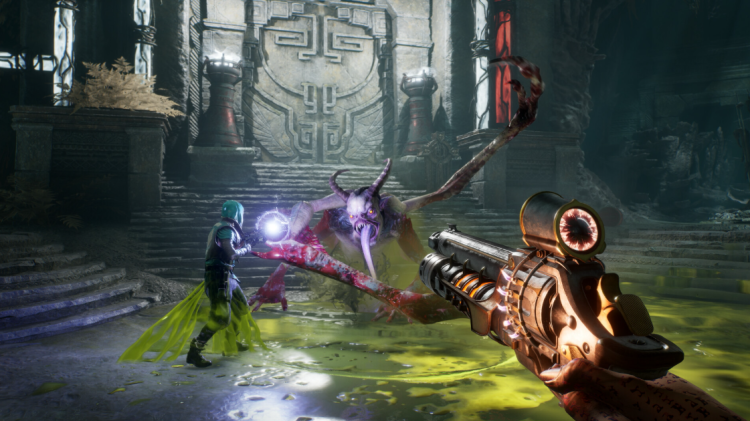
The tarot system returns as well, though in a sharply altered state. Cards now draw from a lottery system, with currency spent to unlock temporary bonuses and another currency required to restore them after use. The loop encourages choice between preparing cards or improving weapons. The economy stays closed, and there is no premium currency or battle pass; a cosmetic season pass stands apart. That restraint offers clarity, although the core mechanic often feels like a churn of limited resource management more than a path toward empowerment.
Borger draws attention to presentation decisions. Environments range in theme but blend under consistent texture and space. Wide arenas and corridor bridges carry heavy textures and elements of doomish industrial dread but lack distinct silhouettes or memorable landmarks. The enemy roster follows suit. Cohort swarms fill screens, larger demons punctuate arenas, and the Nephilim bosses cap acts with spectacle, yet outside those climactic fights, most opponents blur into an indistinct catalog of shapes. None shares the original’s surreal menace. There are no psychotic nuns or monstrous bikers, only shapes shaped for function.
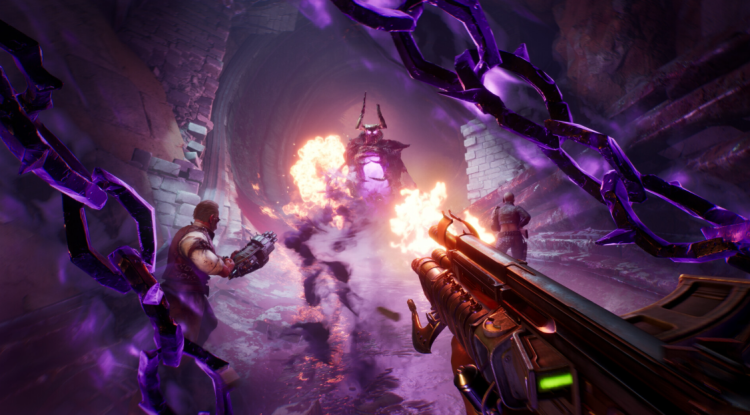
The Nephilim encounters mark the clearest ascent, with each boss introducing set-piece clarity: a massive blood rat, a concealed statue, a dragon that fills the battlefield with threat. Mechanics hew to familiarity, but execution carries weight. Across roughly four hours of campaign content, these peaks arrive rarely but reliably, anchoring the game’s best foot forward. Outside of these moments, arena fights stretch long, demanding execution more than imagination.
Characters form a strange middle ground. Sol and Void emerge with personality, while Ink and Roch occupy darker edges of sarcasm and tragedy. Their banter and story tidbits hold promise, although encounter triggers often cut dialogue short. Voice performances carry conviction yet break under pacing decisions. Story beats move quickly, rarely pausing to deepen motive or emotion. Players may scroll through logs at the home base, though unvoiced text cannot substitute for spoken interplay that fades mid-sentence under combat priority.
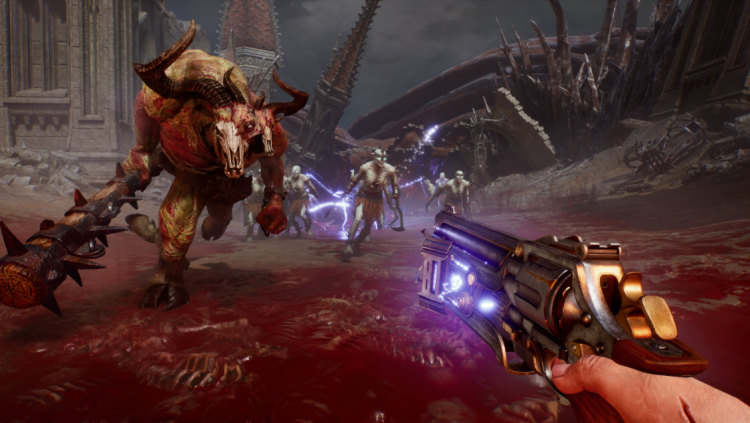
Painkiller’s co-op frame supports three players, with bots available to fill space. They follow commands and function cleanly, though human awareness would always serve better. Playing alone never feels broken, only muted. The structure expects camaraderie, casual coordination, and steady progress. Commands allow bots to activate switches, though the flow suffers when improvisation meets menu instruction.
The campaign concludes on an abrupt pivot. After clearing the levels, the antagonist Azazel delivers a line offering “a higher difficulty” and more violence rather than resolution. The moment echoes the game’s thematic purgatory, not as commentary but as absence. A final push never arrives. Instead, the story opens a door to endless escalation rather than closure or friction.

The roguelike mode stands apart. Randomized layouts, varied room types, platforming interludes, and new combinations of weapons and tarot interactions give the mode energy. Progression feeds back into the main game, and novelty keeps repetition at bay. Yet stability wavers. Borger recounts a crash during the first run, a literal break in the only mode that consistently breathes new life into the concept. Across both campaign and roguelike, performance holds on average, though occasional stumbles leave a mark.
Throughout the review, Borger returns to tone. Painkiller, once a loud statement of arcade violence and heavy-metal surrealism, now feels restrained, polished, and market-aligned. The raw identity of the original dissolves into a broader service-shooter mold, one that functions but never pulses. This is not a condemnation so much as a diagnosis. A framework exists, a sense of motion and power remains, and weapon feedback lands. Yet the aesthetic spark never ignites. The world feels assembled rather than summoned.

No line in the review overreaches. Praise lands where earned: movement, guns, boss fights, and the occasional character beat. Critique rests on repetition, lack of imagination, and story interruptions. Borger does not argue the game fails outright. Instead, he finds it suspended between ambition and outcome, never sinking, never rising. It is a place of in-between, accurate to the narrative setting of Purgatory but hollow as a path for a franchise with a once-fierce image.
Elsewhere in the co-op space, identity remains the differentiator. The shooters Borger cites as favorites hold their mark through tone, structure, or world design. Here, Painkiller stands as an experiment caught in the gravitational pull of industry templates. The absence of microtransactions in core progression softens skepticism, yet the sense remains that the game exists in a marketplace rhythm rather than a creative one. It has systems, not a soul.
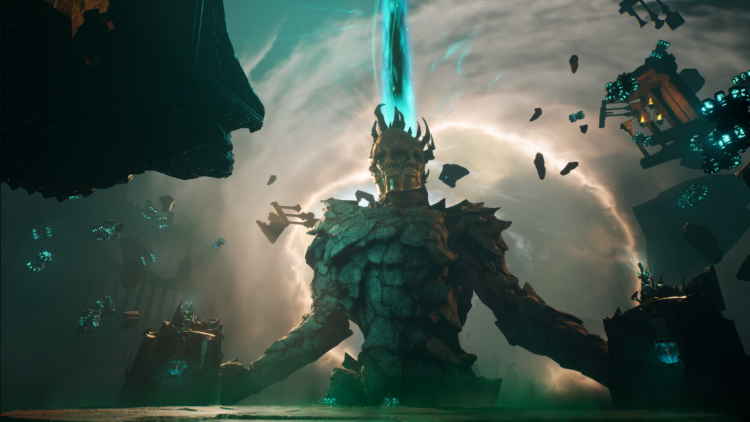
Across the closing paragraphs, Borger lands on a steady conclusion. Painkiller is not terrible, nor is it good enough to revive or redefine its name. It is a competent facsimile with pockets of joy and long stretches of routine. Movement powers excitement. Guns sparkle in their best moments. Yet mission structure, enemy identity, and narrative momentum sag. The roguelike mode offers a glimpse of what might have been: unpredictable motion through chaotic rooms, influence layered onto discovery, tension fed by novelty. That version feels vibrant. The main path does not.
This return to Painkiller serves as a reminder of the challenges of reviving dormant action franchises in a climate oriented around retention and structure. Energy alone cannot sustain a legacy. Mechanical competency cannot substitute for personality. Familiar names and shapes cannot carry expectations without ingenuity. What remains here is a game determined to prove it belongs in a modern context without fully convincing itself.
As Borger writes, this is a work caught between heaven and hell, neither triumph nor calamity. It slides, shoots, and upgrades with confidence, but it never elevates its foundation, never leans fully into the strange or the absurd. The original’s roar becomes a practiced shout, accurate yet lacking resonance. Those seeking the old fire will not find it here. Those new to the name may enjoy fleeting hours of movement and molten combat before settling into the repetition that defines the campaign. In both cases, the game holds the player at a distance.
The Painkiller reboot arrives with the weight of expectation and the shape of conformity. Its presence feels temporary, a season’s curiosity rather than a lasting return. What energy emerges does so through speed, momentum, and the spark of weapon experimentation. Outside that core, the world fades quickly. Purgatory stands still. The gates remain closed on both sides.
Painkiller is available on PC (Steam) now.
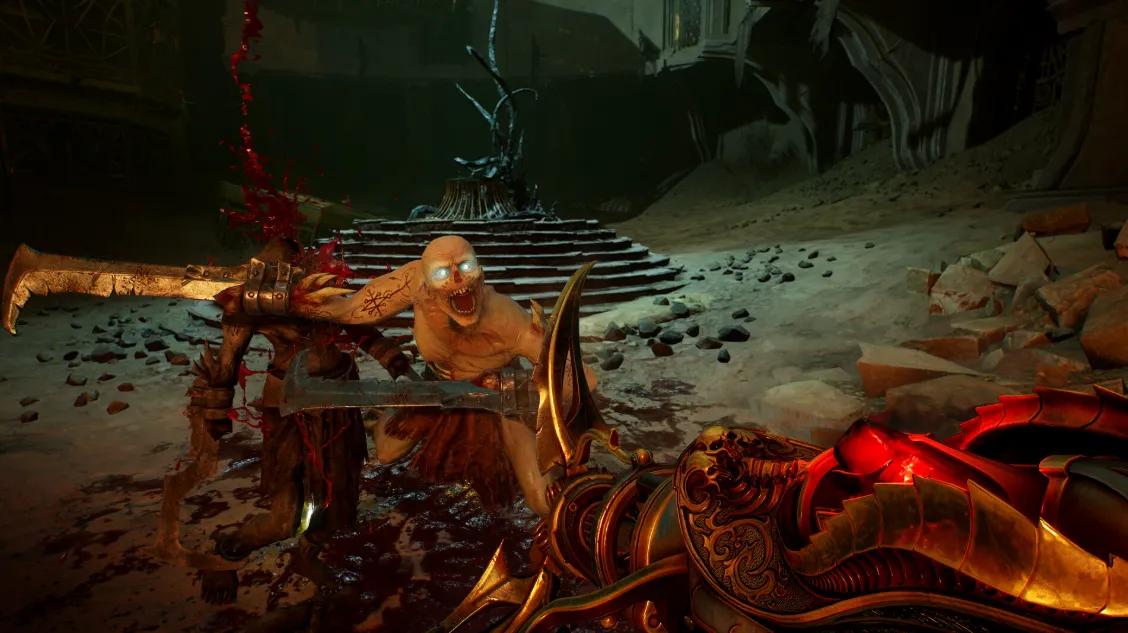

Yorum